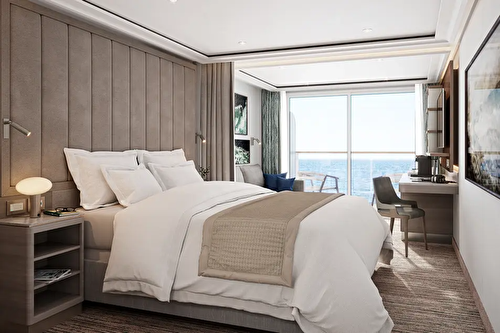Barcelona to Monte Carlo
- 23 Aug ‘26
- 7 nights
- Departing from Barcelona
- Silver Ray
-
Inside price fromCall for price
-
Outside price fromCall for price
-
Balcony price fromCall for price
-
Suite price from$12,100*/pp
YOUR ITINERARY
Barcelona, Spain - Palma De Mallorca, Spain - Valencia, Spain - Cartagena, Spain - Palamos - Saint Tropez, France - Monte Carlo, Monaco
The infinite variety of street life, the nooks and crannies...
The infinite variety of street life, the nooks and crannies of the medieval Barri Gòtic, the ceramic tile and stained glass of Art Nouveau facades, the art and music, the throb of street life, the food (ah, the food!)—one way or another, Barcelona will find a way to get your full attention. The capital of Catalonia is a banquet for the senses, with its beguiling mix of ancient and modern architecture, tempting cafés and markets, and sun-drenched Mediterranean beaches.
A stroll along La Rambla and through waterfront Barceloneta, as well as a tour of Gaudí’s majestic Sagrada Famíliaand his other unique creations, are part of a visit to Spain’s second-largest city. Modern art museums and chic shops call for attention, too. Barcelona’s vibe stays lively well into the night, when you can linger over regional wine and cuisine at buzzing tapas bars.
The Balearics are comprised of 16 islands; the thre...
The Balearics are comprised of 16 islands; the three principal ones are Mallorca, Ibiza and Minorca. Carthaginians, Romans, Vandals and Arabs have invaded these islands over the centuries. Ruins show evidence of the prehistoric Talayot civilization, a megalithic culture that flourished here between 1500 BC and the Roman conquest. Today the islands are besieged by invaders of a different sort – hordes of tourists.
Lying 60 miles (97 km) off the Spanish mainland, the islands’ lush and rugged landscape combined with an extremely mild, sunny climate proves irresistible, especially to northern Europeans. As a result, the Balearics boast cosmopolitan resorts with lively nightlife and plenty of sports activities.
Mallorca (also spelled Majorca) is the largest of the islands, with an area of more than 1,400 square miles (3626 sq.km). The scenery is magnificent, with cliffs along indented shorelines jutting out of the sea and mountain ranges sheltering the plains from harsh sea breezes. The fertile plain in the centre is covered with almond and fig trees plus olive groves with some trees more than 1,000 years old. Tall pines, junipers and oaks line the mountain slopes.
Palma de Mallorca is the capital of the archipelago. A cosmopolitan city with sophisticated shops and restaurants, it also offers buildings of spectacular Moorish and Gothic architecture.
In the western part of Mallorca, nestled into the mountains, lies the village of Valldemosa. It is known for its Carthusian Monastery where Frédéric Chopin and George Sand spent the winter of 1838-39.
Valencia is Spain’s third largest city and capi...
Valencia is Spain’s third largest city and capital of the region. It was originally founded by the Romans on the banks of the river Turia in 138 BC. In 711 AD the Moors arrived and converted the area into a rich agricultural and industrial center, establishing ceramics, paper, silk and leather industries. Muslim rule was briefly interrupted in 1094 by the legendary Castillian knight, El Cid. Valencia boomed in the 15th and 16th centuries, becoming one of the strongest Mediterranean trading centers.
Valencia is a vibrant, friendly and chaotic city that boasts an outstanding fine arts museum and one of the most exciting nightlife scenes in Spain. The city center is about 3 miles inland from the coast. Plaza del Ayuntamiento marks the center of Valencia. Surrounded by flower stalls, it is also home to the town hall and the main post office. The cathedral was begun in the 13th century and finished in 1482. It has many architectural styles, including Gothic, Baroque and Romanesque. The octagonal bell-tower, called Miguelete, is one of the city’s landmarks. The small cathedral museum boasts a tabernacle made from 550 pounds of gold, silver, platinum, emeralds and sapphires. It also purports to be the home of the Holy Grail, the cup used by Christ at the Last Supper.
West of the cathedral is the oldest part of the city, known as El Carme. Situated across the river in the Jardines del Real is the Museo de Bellas Artes, the Fine Arts Museum. Works include those by El Greco, Goya and Velázquez.
On the crossroads of mighty cultures, this Murcian port has endl...
On the crossroads of mighty cultures, this Murcian port has endless ancient stories to share. A valuable natural harbour attracted many civilisations to this sun-bathed, southeasterly setting – following its foundation by the Carthaginians in 227 BC. Blending the imprints left by countless cultures on this global junction, the presence of everyone from the Vandals to the Phoenicians and Moors can be felt as you explore, walking between ruins and celebrated modernist architecture along Calle Mayor. Cartagena is crowned by the soaring Castillo de la Concepcion – rise to the stout castle aboard a panoramic lift. Inside, look through reams of archaeological treasures, or admire the rolling views down over the port and across the waters. Watch out for the electric blue peacocks who strut flamboyantly. Cartagena’s emergence as a visitor destination coincided with a stunning discovery in 1988 – the bowl of a gloriously preserved Roman Theatre. Enter to sit among the grandiose ancient venue, so evocative, you can’t help but imagine the historic performances that have graced its stage. Wander the breezy waterfront, looking across the narrow strait towards Africa’s distant haze, and spotting gleaming warships. Cartagena’s perfect harbour means it has been one of Spain’s oldest strategic navy positions since the 16th century. Settle to enjoy the joys of tapas in lively bars – sampling crisped paella, squid and honeyed-aubergine. Easter’s Semana Santa festivities are typically lively here, as hooded processions, lavish floats and sombre fiery displays roll through the streets.
A glitzy, glamorous coastal resort that needs no introdu...
A glitzy, glamorous coastal resort that needs no introduction, Saint Tropez is the French Riviera hotspot of choice for A-listers and flotillas of gleaming yachts. The sparkle of its beaches, and clarity of its light, continues to attract artists – but it was the famous presence of Brigitte Bardot that leant Saint Tropez its enduring glamour and steamy appeal. Nowadays, speedboats skim offshore, while fine vintages from the vineyards nearby are uncorked in top-notch restaurants, in this well-heeled highlight of the Cote d’Azur. View less
Famous bars offer views of the port along Quai Jean Jaurès, with its iconic cherry-red directors’ chairs. Here you can admire the monstrous wealth of yachts that sparkle on the waters. On the same corner, big-name brand labels glimmer in the shops of rue François Sibilli – which cuts inland from the charming waterfront. The earthier appeal of boules clinking and thumping into the ground can be enjoyed at Place des Lices, where sun-wrinkled locals compete. Saint Tropez has a few beaches of its own, but famous stretches like Pampelonne Beach draw the biggest crowds to relax on star-studded golden sands. La Ponche, the authentic fishing quarter, retains its cobbled, historic elegance, and a 17th-century, hexagon-shaped citadel watches over the city and coastline from above. Coastal walks in the sea air snake away from the city’s bustle, and a series of headlands shape the stunning riviera landscape surrounding Saint Tropez. The historic monochrome Cap Camarat lighthouse adds a pleasing accent to hikes above the sparkling Mediterranean’s waves.
The independent principality of Monaco is famous as the ...
The independent principality of Monaco is famous as the playground of the Côte d’Azur. With sandy beaches, elegant hotels and a vibrant nightlife, this tiny domain is a favourite haunt of the jet set. In the possession of the Grimaldi family for more then 700 years, treaties with France guarantee Monaco’s independence.
The population of the fashionable enclave is 32,000 citizens, for an area smaller than New York’s Central Park, but it boasts some of the most expensive real estate in the world. In addition to its luxury hotels and beautiful beaches, Monaco is noted for its mild climate and magnificent scenery. Once an exclusive wintering stop for Europe’s aristocracy and royalty, today there are more than 5 million visitors annually. Of the principality’s four sections – La Condamine, Fontvieille, Monaco-Ville and Monte Carlo, the latter two rank highest on every visitor’s must-see list.
In Monte Carlo, the Grand Casino and Opera is perhaps Monaco’s most outstanding attraction. For more than a century, the principality’s livelihood was centred beneath the copper roof of this splendid establishment. The resemblance to the Paris Opera House is less than accidental since they share the same architect, Charles Garnier. Also facing the square are the famed Hotel de Paris and the more modest Café de Paris. Monte Carlo spells sophistication; it is the epitome of elegance and glamour. Year after year, the rich and famous of business and entertainment gather here to bask in the sun, gamble at the world’s most opulent casino and attend spectacular parties. Nothing typifies more the elegant lifestyle of the Côte d’Azur than glamorous Monte Carlo.
Situated on a rocky peninsula, Monaco-Ville comprises the old town and the seat of Monaco’s government. Narrow streets lead to the Prince’s Palace high above the sea. The 19th-century Romanesque cathedral contains impressive works of art and the tombs of Princess Grace and Prince Rainer III, while the Parliament building and the Oceanographic Museum offer additional points of interest.
As if Monaco’s splendid attributes weren’t enough, the surrounding areas with their incredibly beautiful scenery are additional attractions.
YOUR SHIP - The Silver Ray
Silversea’s second Nova Class ship arrived in summer 2024 and promises guests seamless destination connection. Silver Ray mirrors every aspect of her sister ship, Silver Nova, including a pioneering, asymmetrical design and extraordinary use of glass in both public areas and in suite for uninterrupted views wherever you are! What’s more, Silver Ray is one of the most spacious ships ever built, offering an exceptionally high space-to-guest ratio yet remaining nimble enough to offer purity in movement, as her name suggests. She is truly a ray of light.
Description
Silversea’s second Nova Class ship arrived in summer 2024 and promises guests seamless destination connection. Silver Ray mirrors every aspect of her sister ship, Silver Nova, including a pioneering, asymmetrical design and extraordinary use of glass in both public areas and in suite for uninterrupted views wherever you are! What’s more, Silver Ray is one of the most spacious ships ever built, offering an exceptionally high space-to-guest ratio yet remaining nimble enough to offer purity in movement, as her name suggests. She is truly a ray of light.
STATEROOMS

suite
SIMILAR CRUISES
-
DateTripCruise ShipNightsPrice
-
2026-07-26Barcelona to Monte CarloSilver Ray- 7Nights7
*Based on Twinshare cabin

